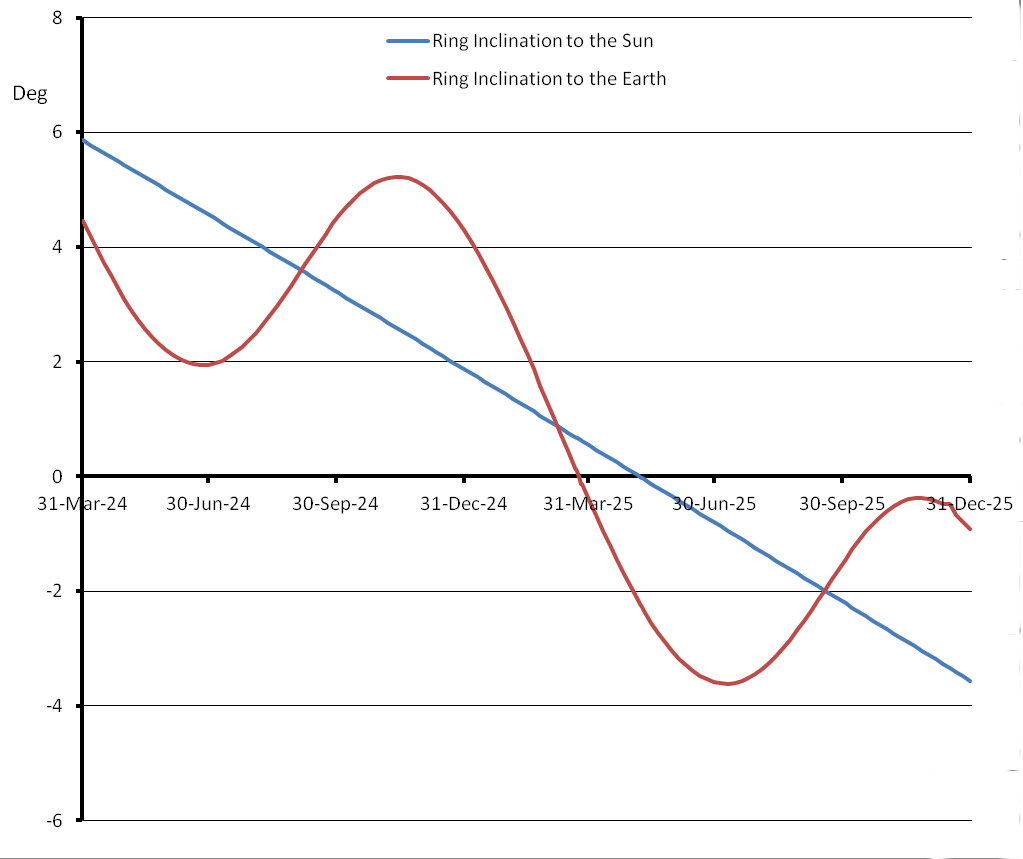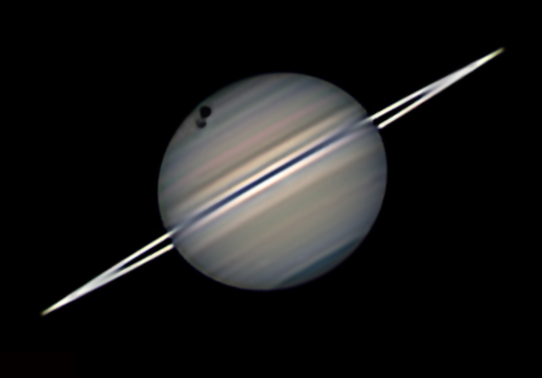2025 November 2
SATURN’S NARROW RINGS AND TITAN TRANSITS

Those who have been observing Saturn recently will have noted how narrow the rings appear.
Earlier this year, on March 23, the rings were edge-on to the Earth. They were then edge-on to the Sun on May 6. The south face of the rings is now presented to both the Earth and the Sun.
As shown in Figure 1, the inclination to the Sun is now slowly increasing in value. However the inclination to the Earth oscillates around the Sun inclination due to the fact that the Earth’s orbit is inclined to that of Saturn.
During late June/early July the south face of the rings reached a maximum inclination of approximately 3.6 degrees relative to the Earth. However since this time, the inclination has been decreasing and will reach a minimum of just below 0.4 degrees during mid November/early December. After this time, it will increase again. This period will therefore be the last time to observe very narrow rings until around the time of the next equinox in 2039 January.
As the orbital planes of the satellites from Titan inwards lie close to the plane of the rings, eclipses, occultations and transits of these satellites have been occurring. Transits of Rhea, Dione and Tethys require larger instruments to detect. However a transit of Titan is easier to observe as it appears larger and dark. The shadow can also be detected with smaller instruments.
Various Titan phenomena have been occurring during this apparition. Over the last few months, a number of shadow transits have occurred which have been well observed from longitudes of the Americas. On September 21 (the day before opposition) a transit of both Titan and its shadow was observed as shown in Figure 2.
Now a series of Titan transits and occultations will be visible from the UK and some European longitudes until 2026 January. One such transit occurs on Christmas Eve. The transits will track across Saturn’s northern hemisphere and dates/times are given in the BAA Handbooks for 2025 and 2026.Alternatively, details for a given geographical location can be found by using software such as WinJupos.
Similar transits will not occur again until around the time of the next equinox, although their visibility from the UK has still to be derived.
It will be interesting to find what is the smallest telescope that can be used to detect these transits.
Observations can be sent to the Saturn, Uranus and Neptune section and also posted on the BAA Gallery.
Mike Foulkes Director, Saturn, Uranus and Neptune Section.
Figure captions.
Figure 1. Inclination of Saturn’s rings to both the Earth and Sun During 2024 2025. Positive values show the north face of the rings are presented to either the Earth or the Sun. Negative values show the south face of the rings are presented to the Earth or the Sun.

Figure 2.

2025 Sept 20. 05:42.8 UT. Gary Walker. 254Mm A-P Mak-Cas. RGB image. Shows Titan and its shadow in transit with Titan Sf of its shadow, North is up.
| The British Astronomical Association supports amateur astronomers around the UK and the rest of the world. Find out more about the BAA or join us. |
